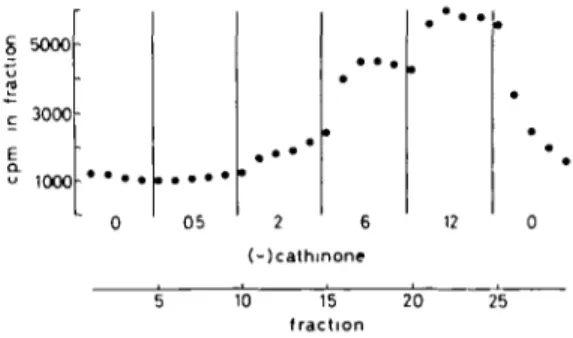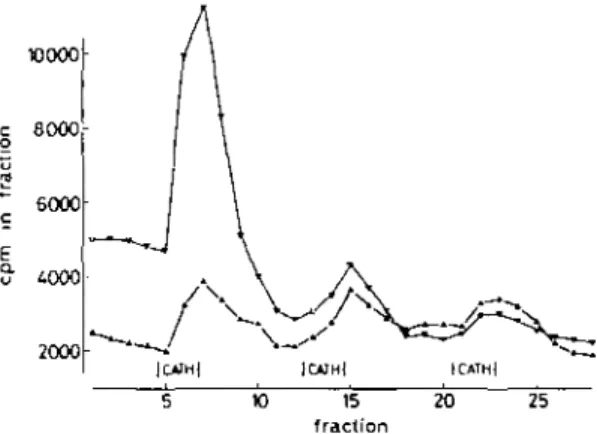Alcoholrf Akohotisin.\'o\ 18, No 4. pp 301-303.1983
Prinfcd in Circal Briiain
03O9-I635/S3S3 00 + 0 00 Pergamon Presi Lid Medical Council on Alcoholism
5000 3000 1000 0 • • • • • 05 2 6 * 12 (-)cathinone
MECHANISM OF ACTION OF (-)CATHINONE, A NEW ALKALOID
FROM KHAT LEAVES
PETER KALIX
Department de Pharmacologie, Centre MedicaJ Universitaire, CH-1211 Geneve 4, Switzerland
{Received 1 April 1983)
Abstract — A new alkaloid, (-)cathinone, has recently been isolated from khat leaves and has been
shown to induce amphetamine-like behavioural effects. The actions of this alkaloid at the cellular level are discussed here and it is concluded that (-)cathinone resembles amphetamine in influ-encing catecholamine release both centrally and peripherally. As it is likely that the central and peripheral symptoms observed during khat consumption are due to these effects of (-)cathinone, it can be assumed that the widespread habit of khat chewing is pharmacologically analogous to amphetamine abuse.
INTRODUCTION
Because of their stimulant effect, fresh leaves of the khat shrub are chewed habitually by many people in East Africa and the Arab Peninsula. The consumption of khat causes sympathomimetic effects and induces symp-toms such as euphoria and hyperactivity (Halbach, 1972). The tendency of many khat users to obtain their daily supply of the drug by any means is a clear manifestation of psychic dependence.
Recently, the new alkaloid (-)cathinone (chemically a-amino-propiophenone) has been isolated from khat leaves and has been reported to produce pharmacological effects that closely resemble those of amphetamine, for example anorexia (Zelger and Carlini, 1980), hyperther-mia (Kalix, 1980a), and hypermotility (WHO Advisory Group, 1980; Zelger et al., 1980; Kalix, 1980b; Valterio and Kalix, 1982). In all these respects the alkaloid has been found to have a potency similar to that of ( + )am-phetamine. The experiments whose results are described and discussed in the present article were designed to find out if (-)cathinone acts also at the cellular level by a mechanism resembling that of amphetamine.
RESULTS AND DISCUSSION The effect of (-)cathinone on the efflux of radioactivity from rabbit striatal slices
pre-15 fraction
20 25
Fig. 1. Effect of increasing concentrations of (-)cathinone on the efflux of radioactivity from rabbit striatal tissue prelabelled with 3H-dopamine. Each fraction corresponds
to 3 min of efflux. For details see Kalix (1981).
3000 1000 • • • • A M P H -• - CATH — 10 15 fraction 20 25
Fig. 2. Effect of 3 |iM ( +(amphetamine and of 6 uM (-Kathinone on the efflux of radioactivity from rabbit striatal tissue prelabelled with H-dopamine. For details,
see Kalix (1981) 301
302 P. KALIX
rCATH
3000
1000
rLAI n—j pLAI H-iCATH-, o MA2IND0L ,-CATH-r-CATH-,1 Qtlft* I l.20>*l '
[-AMPH-, 1 0.60v« ' t t 10 15 20 fraction 25
Fig. 3. The effect of mazindol on the (-)cathinone-induced release of radioactivity from rabbit striatal tissue prelabell-ed with H-dopamine. Two preparations from the same animal were superfused in parallel and stimulated twice with 10 ujvl (-)cathinone during 12 min. Before and during the second stimulation the test preparation ( • ) was super-fused for 24 min ( o ) with 1 uM mazindol. The efflux from the control preparation is indicated by mangles. For
details, see Kalix (1982).
Z 3000
1000
FT"-"] [
AMPH-,20 25
Fig. 4. The effect of (-)cathinone and (+ )amphetamine on the release of radioactivity from rat nucleus accumbens tissue prelabelled with 3H-dopamine. The efflux from an
unstimulated control preparation superfused simul-taneously is indicated by open triangles. For details, see
Kalix (1982).
labelled with 3H-dopamine was examined. It was found that low concentrations of (-)cathinone enhanced the release of label in a dose-dependent manner (Fig. 1), and that (-)cathinone was capable of sustaining the enhanced release induced by ( + )amphetamine (Fig. 2).
Pretreatment of the tissue with mazindol, which is known to prevent the induction of release by ( + )amphetamine, inhibited the ef-flux increase caused by (-)cathinone (Fig. 3). In further experiments with dopamine-prelabelled tissue, the new alkaloid was found to cause release also from the nucleus accumbens (Fig. 4), a brain region thought to be critically in-volved in the locomotor response to am-phetamine. Taken together, these observations suggest that (-)cathinone is a central stimulant with a mechanism of action analogous to that of amphetamine. f, 3000 1000 15 fraction 20 25
Fig. 5. Effect of (-)cathinone and of ( +(amphetamine on the efflux of radioactivity from rabbit atrium tissue prelabelled with 3H-noradrenaline The efflux from an
unstimulated control preparation superfused simul-taneously is indicated by open triangles. Each fraction cor-responds to 3 min of efflux. For details see Kalix (1983).
10000 8000 6000 4000 2000 lam ICATH) 15 fraction 20 25
Fig. 6. Repetitive stimulation with 0.80 uM (-)cathinone of the efflux of radioactivity from rabbit atrium tissue obtained from untreated ( A ) or reserpinized ( V (animals and prelabelled with 3H-noradrenaline. Reserpine
(Ser-pasil®) was injected intramuscularly 20hr before the ex-periment at a dose of 2 mg/kg. For details, see Kalix (1983).
Characteristically, the consumption of khat is accompanied by sympathomimetic effects, especially at the cardiovascular level. There-fore, it was subsequently investigated if the releasing effect of (-)cathinone observed in the CNS occurred also in peripheral tissues. When slices of rabbit atria that had been prelabelled with 3H-noradrenaline were superfused with solutions of either (-)cathinone or ( + )am-phetamine, a rapid increase in efflux of radioactivity was observed (Fig. 5). In tissue obtained from reserpinized animals the releas-ing effect of (-)cathinone, as well as that of ( + )amphetamine, was characterized by rapid development of tachyphylaxis (Fig. 6).
MECHANISM OF ACTION OF (->CATHINONE 303 The results of the experiments described here
indicate that (-)cathinone has an amphetamine-like releasing effect at central dopaminergic synapses as well as at peripheral noradrenaline storage sites. As it is likely that the central and peripheral symptoms observed during khat con-sumption are due to this effect of the alkaloid, it can be concluded that the widespread habit of chewing khat is pharmacologically analogous to amphetamine abuse.
REFERENCES
Halbach, H. (1972) Medical aspects of the chewing of khat leaves. Bulletin of the World Health Organization 47, 21-29.
Kalix, P. (1980a) Hyperthermic response to (-)cathinone, an alkaloid of Catha edulis (khat). Journal of Pharmacy
and Pharmacology 32, 662-663.
Kalix, P. (1980b) Hypermotility of the amphetamine type induced by a constituent of khat leaves. British Journal
of Pharmacology 68, 11-13.
Kalix, P. (1981) Cathinone, an alkaloid from khat leaves with an amphetamine-like releasing effect.
Psycho-pharmacology 74, 269-270.
Kalix, P. (1982) The amphetamine-like releasing effect of the alkaloid (-)cathinone on rat nucleus accumbens and rabbit caudate nucleus. Progress in
Neuro-Psycho-pharmacology and Biological Psychiatry 6, 43-49.
Kalix, P. (1983) Effect of the alkaloid (-)cathinone on the release of radioactivity from rabbit atria prelabelled with
3H-norepinephnne. Life Sciences 32, 801-807.
Valteno, C. and Kalix, P. (1982) The effect of the alkaloid (-(cathinone on the motor activity of mice. Archives
Internationale de Pharmacodvnanue el de Therapie 255,
196-203.
World Health Organization Advisory Group Report (1980) Review of the pharmacology of khat. Bulletin on
Nar-cotics 32, 83-93.
Zelger, J. andCarlini, E. (1980) Anorexigenic effect of two amines obtained from Catha edulis Forsk. (khat) in rats.
Pharmacology, Biochemistry and Behavior 12, 701-705.
Zelger, J., Schorno, H. and Carlini, E. (1980) Behavioural effects of cathinone, an amine obtained from Catha

